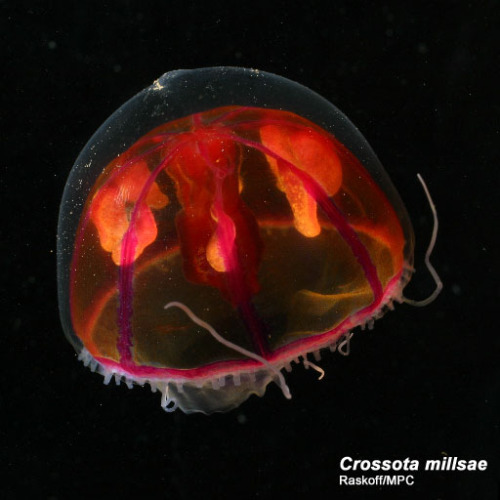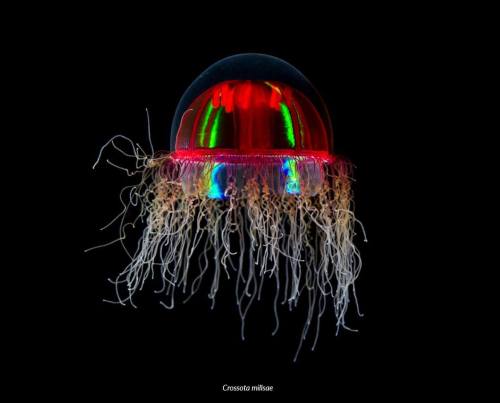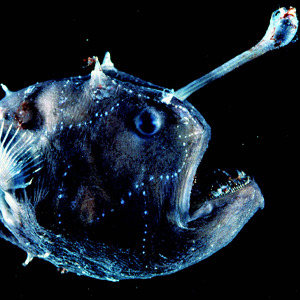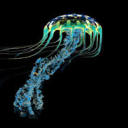Sea Sparkle Is A Common, Bioluminescent Plankton. Even Though Its Not An Animal, It Is Worth Sharing.
Sea sparkle is a common, bioluminescent plankton. Even though its not an animal, it is worth sharing.


Sea sparkle
Noctiluca scintillans
Sea sparkle is a bioluminescent dinoflagellate that blooms in many coastal waters. Sea sparkle feeds on plankton, diatoms, fish eggs, and other dinoflagellates. It also has a flagellum, or tiny tail, that helps it move around in the water. Even though sea sparkle is beautiful to witness at night, it is hazardous to other marine species and resembles a reddish-pink film during the day.
Photo credit:
https://alexandrathemb.tumblr.com/post/49814932878/noctilucas-scintillans-a-bioluminescent
https://thevelv.blogspot.com/2015/07/noctiluca-scintillans.html
More Posts from Bioluminescentoceangoddess and Others

Marrus orthocanna
Marrus orthocanna is a deep sea siphonophore found at depths between 400m to 2200m. It has a colony of gas-filled zooids on the top used for locomotion. It also has a long, bright orange tentacles on the bottom. Marrus orthocanna are viscous predators and consume small crustceans and copepods.
Photo credit: http://www.arcodiv.org/watercolumn/cnidarian/Marrus_orthocanna.html


Sea elephant
Carinaria japonica
The Sea Elephant is a translucent sea snail that has a large muscular body and a tiny triangular shell. Its foot is used for crawling on the ground, and it can be transformed into a fin that is used for swimming. It is called the “sea elephant” because it has a small trunk in its mouth that is used to swallow prey. Furthermore, the Sea Elephant eats arrow worms and jellies.
Photo credit
https://bodegahead.blogspot.com/2014/12/carinaria-part-2.html
http://tolweb.org/Carinaria_japonica/28750


Spookfish
Winteria telescopa
The Spookfish’s eyes act as a telescope and are designed to maximize light in the deep ocean. Its eyes contain rod cells that help distinguish between ambient light and bioluminescent light. This adaptation helps avoid predators and catch prey.
Picture Credit: https://www.natureplprints.com/deep-sea/deep-sea-fish-winteria-telescopa-15230734.html


Psychedelic Medusa
Crossota millsae
The Psychedelic Medusa is a deep-sea hydrozoan that is abundant in the North Pacific. The mini-jelly is found at depths between 1000m to 3800m, and are often observed drifting near the ocean floor. It also has an eccentric reproduction behavior uncommon in cnidarians. The females display viviparity, and carry the babies in her bell until they are ready to hatch.
Photo credit: http://www.arcodiv.org/watercolumn/cnidarian/Crossota_millsae.html
https://twitter.com/spothvegr/status/1030177493075079169


Jewel Squid
Histioteuthis heteropsis
The Jewel Squid is covered in color-changing photophores that resemble sparkling gem stones. They also have a light-red coloration and are about 20 cm in length. They display a unique behavioral adaptation called diel migration. During the day, they stay at depths around 400-1200 m, and then surface during night (0-400m). This behavioral pattern is designed maximize feeding at night, and avoid predators during the day. The primary predator of the Jewel Squid is the Sperm Whale.
Photo credit: https://www.pinterest.com/pin/722827808920240115/
https://twitter.com/theoctonation/status/1168516522270253056

Hula Skirt Siphonophore
Physophora hydrostatica
The Hula Skirt Siphonophore a deep sea siphonophore that is found between 700 m to 1000m. It is made of a colony of hundreds tiny zooids. The top portion of the colony holds the swimming bells, which allow the colony to move. The bottom of the siphonophore holds the orange ‘hula skirt,’ which is full of stinging tentacles.
Photo link : https://twitter.com/montereyaq/status/1162068535331311617?lang=da


Football Fish
Himantolophus paucifilosus
The Football fish is a deep sea angular fish located between 1000 to 4000 meters in the ocean. The glowing dots on its body are sensory organs called neuromast that help the fish detect changes in the water.
Photo credit: https://alchetron.com/Footballfish
https://www.amazon.com/Creatures-Deep-Search-Monsters-World/dp/1770852816


Pink Helmet
Aglantha digitale
The Pink Helmet is a mini hydromedusa that comes in a variety of vibrant colors. The tiny jelly is only 4 cm in size and is found towards the surface of the ocean. The purple and blue hues we see in its bell are caused by a phenomenon known as iridescence, when light strikes the jelly’s thin tissue at different angles (similar to what we see in a soap bubbles). It also has orange pigmentation near its mouth; this pigmentation helps attract prey and mask luminescence. Furthermore, females tend to be more colorful than males.
Photo credit: https://biolum.eemb.ucsb.edu/organism/pictures/aglantha.html
https://www.pinterest.com/pin/186899453255850798/


Cockatoo Squid
Galiteuthis phyllura
The Cockatoo squid is a highly-specialized oddity of the deep ocean and found at depths between 300 to 1400 m. It is completely transparent, except for its eyes. It also has bioluminescent photophores that are directed downward: this makes it difficult for deep sea predators to see the Cockatoo Squid. It was named after the Cockatoo because it holds its tentacles above its head, resembling the bird. The Cockatoo squid can also get fairly large with adults reaching lengths of 2.7 meters (over 6 ft.)
Photocredit: https://www.americanscientist.org/article/at-home-in-the-dark
https://www.pinterest.com/pin/28710516347382519/


Blacksnout Seasnail
Paralipparis copei copei
The Blacksnout Seasnail may not look like a snail, but it does have a slimy, gelatinous substance that covers its body. It can be found at depths between 200 m to 1692 m, and adults grow up to be 17 cm in size (approximately 6.5 in). It also has an elongated body that resembles an eel. Furthermore, it can be seen rolling itself in a loop; this behavior is a defensive posture that makes it appear like a jelly. In the darkness, predators tend to avoid the Blacksnout Seasnail because its often mistaken as a hunter due to its appearance and behavior.
-
 maxinji liked this · 2 years ago
maxinji liked this · 2 years ago -
 omgsevereengineerbouquet reblogged this · 2 years ago
omgsevereengineerbouquet reblogged this · 2 years ago -
 brittanygca liked this · 3 years ago
brittanygca liked this · 3 years ago -
 buylegitactavis liked this · 3 years ago
buylegitactavis liked this · 3 years ago -
 aganatis liked this · 3 years ago
aganatis liked this · 3 years ago -
 wannabe-etymologist reblogged this · 3 years ago
wannabe-etymologist reblogged this · 3 years ago -
 kindred-is-smiling liked this · 3 years ago
kindred-is-smiling liked this · 3 years ago -
 rororasputin liked this · 3 years ago
rororasputin liked this · 3 years ago -
 serpent-speaking liked this · 3 years ago
serpent-speaking liked this · 3 years ago -
 gayluka liked this · 3 years ago
gayluka liked this · 3 years ago -
 yayee-prsp liked this · 3 years ago
yayee-prsp liked this · 3 years ago -
 chitsangenthusiast reblogged this · 3 years ago
chitsangenthusiast reblogged this · 3 years ago -
 chitsangenthusiast liked this · 3 years ago
chitsangenthusiast liked this · 3 years ago -
 tt-squid reblogged this · 3 years ago
tt-squid reblogged this · 3 years ago -
 butt2rflyeffect liked this · 3 years ago
butt2rflyeffect liked this · 3 years ago -
 so--c0ld reblogged this · 3 years ago
so--c0ld reblogged this · 3 years ago -
 so--c0ld liked this · 3 years ago
so--c0ld liked this · 3 years ago -
 demonic-and-gay-phoenix reblogged this · 3 years ago
demonic-and-gay-phoenix reblogged this · 3 years ago -
 cool-water-stuff reblogged this · 3 years ago
cool-water-stuff reblogged this · 3 years ago -
 jackalyote reblogged this · 3 years ago
jackalyote reblogged this · 3 years ago -
 demonic-and-gay-phoenix liked this · 3 years ago
demonic-and-gay-phoenix liked this · 3 years ago -
 gamuchoko liked this · 3 years ago
gamuchoko liked this · 3 years ago -
 celestebescond liked this · 3 years ago
celestebescond liked this · 3 years ago -
 chiaravecchia reblogged this · 3 years ago
chiaravecchia reblogged this · 3 years ago -
 chiaravecchia liked this · 3 years ago
chiaravecchia liked this · 3 years ago -
 astrotracksuitbattalion liked this · 3 years ago
astrotracksuitbattalion liked this · 3 years ago

Bioluminescence is a chemical reaction that produces light. Many deep sea animals use bioluminescence. This blog is dedicated to educating the public about the amazing creatures that thrive in the deep sea.
57 posts